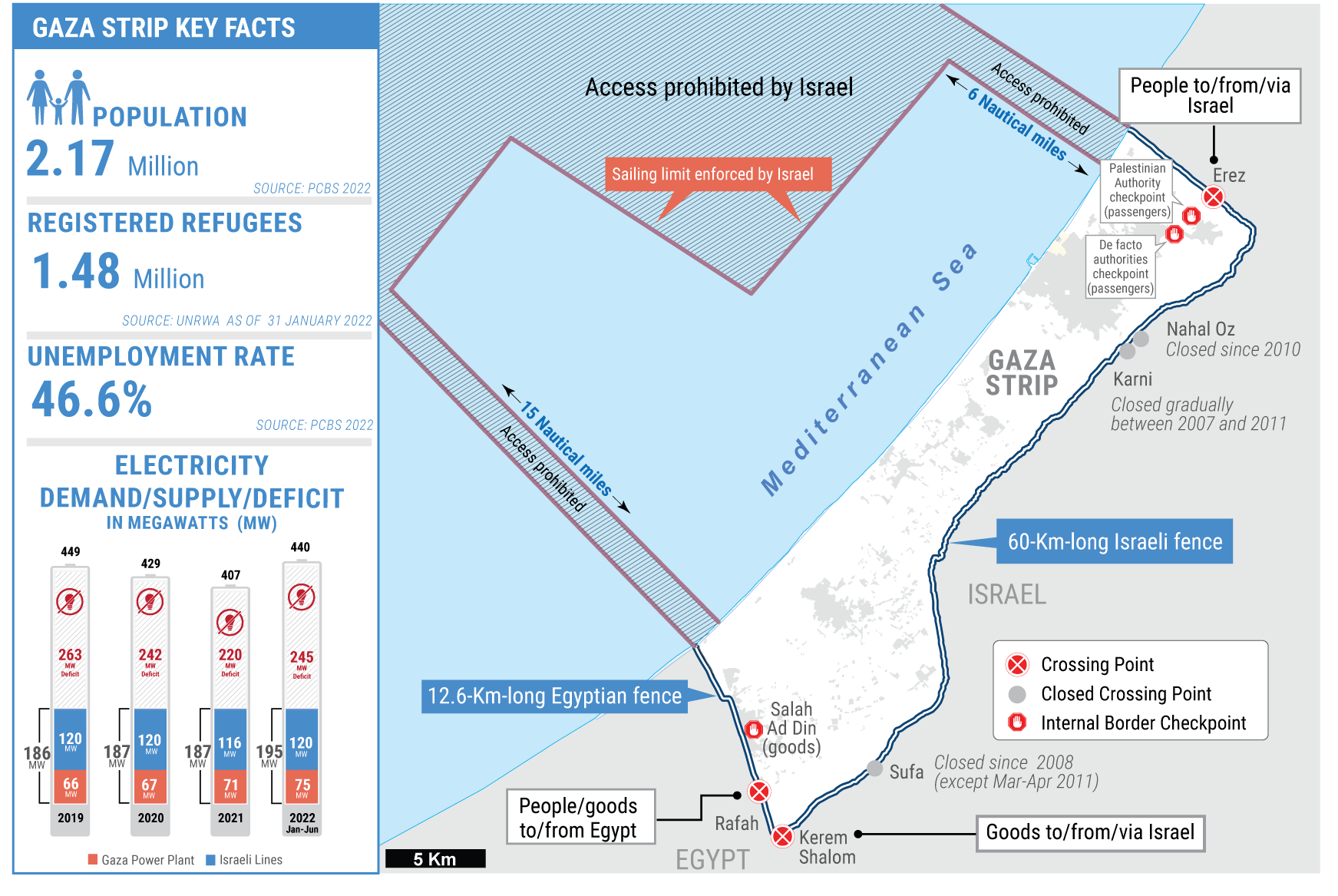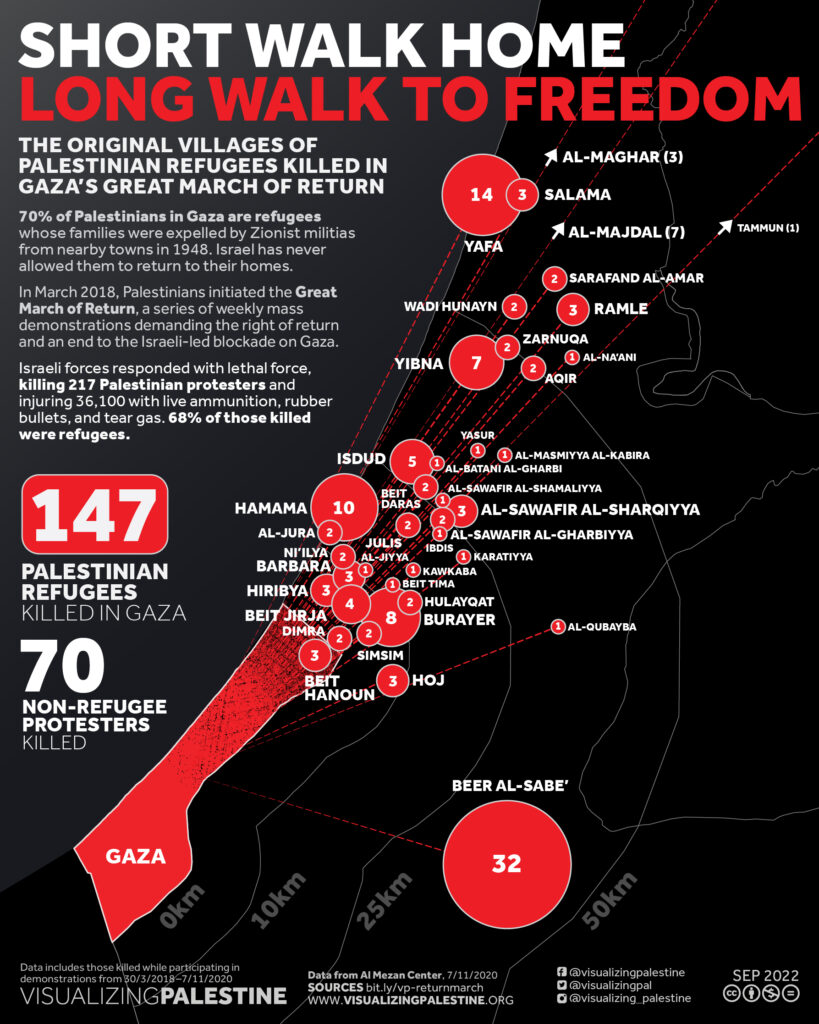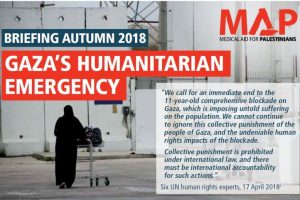Sections:
- Gaza’s Humanitarian Crisis (Written in 2020)
- Illegal Collective Punishment
- Israel’s Military Assaults
- The Great March Of Return
- Fishing In Gaza
Gaza’s Pre October 2023 Humanitarian Crisis
Over 70 years have passed since the Nakba (the Disaster or the Catastrophe) – the forced displacement of the native Palestinian population from what became Israel. The international community is responsible for this refugee situation (see unfulfilled UN Security Council Resolution 194 of 1948). The international community is also responsible for not enforcing Security Council resolution 242; that lack of enforcement has resulted in half a century of military occupation of the West Bank, the Gaza Strip, the Golan Heights and East Jerusalem. For over 70 years the international community has not only stood by as Israel has perpetrated gross violations of individual and collective rights of the Palestinian people; many have in fact protected and supported Israel despite these crimes. The greatest violations are evident in the ongoing blockade of Gaza.
The blockade of Gaza and the unliveable conditions suffered by women, children and men is not a natural catastrophe: it must be understood in its political context.
Israel’s illegal and inhumane blockade of the Gaza Strip since 2007 has created a humanitarian crisis. The blockade has deprived Palestinians in Gaza their right to health, safety and well-being, as well as the right to freedom of movement, among other fundamental human rights.
In 2012, the UN warned that Gaza would be unliveable by 2020 if the blockade continued, but in 2017 the UN’s Coordinator for Humanitarian Aid and Development Activities, Robert Piper, revised that projection stating that the unlivability threshold had already been passed. According to findings of a UN trade and development report dated September 12, 2018, “The productive capacity of Gaza has been eviscerated by three major military operations and a crippling air, sea and land blockade.” That says nothing of the regular smaller military attacks on the Gaza Strip.
Gaza residents live in a man-made catastrophe:
-
- 62% of the 2.1 million Palestinians in Gaza require food assistance (OCHA).
- Most households in Gaza receive piped water only for 6-8 hours each 3 to 5 days (OCHA). The people of Gaza had access to 78 liters per capita per day (2019 average) when the World Health Organization’s minimum recommended amount is 100. (OCHA)
- As of 2022, 78% of piped water in Gaza is unfit for human consumption. (OCHA)
- 2019 saw an increase in electricity from an average of 6.6 to still only 12 hours per day. (OCHA). In 2021 rolling power cuts averaged 11 hours per day. (OCHA)
- 94% of schools in Gaza operate on double shifts due to lack of classroom space. (BBC-UNRWA)
- Gaza’s public health system suffers from shortages in skilled personnel, drugs and disposables, and electricity supply. Many Palestinian patients need to be referred outside of Gaza for regular treatment (permits for travel to receive medical treatment depend on the Israeli authorities see Gisha).
- 110 million liters of raw untreated sewage flow daily from Gaza into the Mediterranean Sea. (PBS)
- 53% of Palestinians in Gaza live in poverty. (OCHA)
- 80% of Palestinians in Gaza depend on humanitarian assistance. (UNRWA)
- 63% of youth are unemployed (OCHA), with overall unemployment at 47%. (OCHA).
- 43% of essential drugs are completely depleted with another 46% with less than one month’s supply remaining. (WHO)

In addition, after the first few weeks of the Great March of Return in April 2018, the UN Office of Coordination of Humanitarian Affairs reported that medical facilities in Gaza, which are already over-strained by the long-standing shortages of medical supplies, electricity and fuel, are struggling to cope with the overwhelming number of casualties. Over 20,000 people were still displaced from the 2014 Israeli attacks at the time of the report in 2018.
In April 2020 as the COVID-19 pandemic is making vast parts of the world experience some restrictions of their freedom of movement, Gaza is also dealing with this threat.The 11 days Israeli attack on Gaza in May 2021 as well as other restrictions by the occupation brought about further deterioration in the economic and humanitarian conditions.
Additional Sources
- Gaza water confined and contaminated visualizing Palestine
- The effects of Israel’s tightened blockade on the economic and humanitarian conditions in the Gaza Strip 10 May – 16 June 2021 by Al Mezan Center for Human Rights Economic costs of the Israeli occupation for the Palestinian people: the Gaza Strip under closure and restrictions (UNCTAD report 2020)
- Euro-Med Monitor “Suffocation and Isolation: 15 years of Israeli blockade on Gaza”
- Gaza Crisis: Early Warning Indicators December 2019. Through the use of infographics, this brief report by OCHA reveals the various aspects of the unfolding humanitarian crisis in Gaza.
- Uninhabitable: Gaza faces the moment of truth – Essay by Jonathan Cook (13 October 2019). In this essay Cook offers relevant context to the situation in Gaza and analyses the continuing humanitarian crisis and its effects on different sections of Palestinian society.
- Israeli NGO B’Tselem’s “Conquer and Divide” interactive platform for showing impact of Israeli land and movement restriction policies.
- Gaza in 2020: A Liveable Place? Report from the Office of the United Nations Special Coordinator for the Middle East Peace Process.
- From Gisha.org (an Israeli not-for-profit organization, whose goal is to protect the freedom of movement of Palestinians, especially Gaza residents), many publications, updates and other resources, inc. FAQs about the Gaza Electricity Crisis and this March 2020 Factsheet on the Kerem Shalom Crossing.
- Gaza Unlocked gives access to first-hand stories from Gaza and information about the blockade from the Quaker organization American Friends Service Committee (AFSC).
- Palestine VR – Glimpse the reality of life in Palestine – hear directly from the people living there, as you embark on tours of six different regions, including Gaza City. See for yourself the daily struggles – but also resilience – of the people in Palestine.
- UNSCO report from 2017 ten years into the blockade.
- Amnesty International’s Apartheid Against Palestinians”.
Videos
Inside the World’s Biggest Prison
Gaza in Context (This short film provides necessary context for understanding the humanitarian crisis that Gaza faces today and highlights Israel’s continuous military aggression against the Strip). https://www.youtube.com/watch?v=bmRPkfAN2EU&feature=emb_logo
Gaza’s Environmental Crisis (This video outlines the escalating humanitarian crisis in Gaza, i.e. the lack of clean water and electricity cuts). https://www.youtube.com/watch?v=R1L23cIT-9I
Ongoing Gaza Closure: The Impact on Daily Life (Video by the Palestinian Centre for Human Rights in Gaza further highlighting the effects of the closure on Palestinian livelihood including its impacts on the agricultural and fishing sector). https://www.youtube.com/watch?v=ymVXef_C97k&feature=emb_logo
-
Illegal Collective Punishment
Israel’s continuous illegal blockade of Gaza and the restrictions imposed on its inhabitants has been recognised by various global organisations and human rights groups as a form of collective punishment of the civilian population of Gaza.
“The whole of Gaza’s civilian population is being punished for acts for which they bear no responsibility. The closure therefore constitutes a collective punishment imposed in clear violation of Israel’s obligations under international humanitarian law” (International Committee of the Red Cross in its News Release of June 2010). This oppression and collective punishment is that much more inhumane because it affects mostly children, the majority of the population in Gaza.
The continued collective punishment of the Palestinian people in Gaza deepens the already tragic psycho-social and health situation. “The enduring deprivation of basic economic, social and human rights inflicts a heavy toll on Gaza’s psychological and social fabric, as manifested by the widespread incidence of post-traumatic stress disorder and high suicide rates” (United Nations Conference on Trade and Development).
In October 2021 Israel designated six Palestinian civil society organizations as terrorists. This is another method of collectively punishing Palestinians for their resistance to the occupation.See our 2022 video:
Online Shopping Exposes Israeli Collective Punishment on Gaza
-
Additional Sources
https://www.972mag.com/the-gaza-siege-isnt-about-security-its-collective-punishment-pure-and-simple/ – Article by Michael Schaeffer Omer-Man (July 10, 2018) outlining the effects of the blockade on Gaza which amounts to a form of collective punishment of the Palestinians in Gaza.
https://www.newyorker.com/news/news-desk/collective-punishment-gaza – Article by Rashid Khalidi (July 29, 2014) highlighting Israeli collective punishment of Gaza due to Palestinian resistance against Israeli political and territorial ambitions.
http://www.pchrgaza.org/files/2010/Illegal%20Closur.pdf – Report by the Palestinian Centre for Human Rights – The Illegal Closure of the Gaza Strip: Collective Punishment of the Civilian Population.
https://www.cartercenter.org/news/upcoming_events/promo/palestinian-civil-society-under-threat.html-– The Carter Center held a conversation with representatives of the six NGO’s focusing international attention on the continued impact of Israel’s terrorist designation and the need for this decision to be reversed.
-
Israel’s Military Assaults
In addition to its illegal and brutal blockade of Gaza, Israel has repeatedly conducted military assaults against the Palestinian people in Gaza, further escalating the humanitarian crisis.
These military assaults have resulted in thousands of casualties and severe damage to civilian infrastructure, including further devastating Gaza’s already precarious health sector.
According to OCHA and UNHCR reports Israel’s attacks in 2014:
killed 2,251 people , including 551 children and 299 women
- wounded 11,231 people
- partly or wholly destroyed 18,000 homes
- damaged 73 medical facilities
- damaged or destroyed 262 schools and 274 kindergartens
Oxfam reported in February 2015 that due to the restrictions on construction materials entering Gaza, at current rates it would take more than 100 years to complete essential building of homes, schools and health facilities in Gaza. According to B’Tselem, as of March 2019, 20% of homes were unusable and 2,300 families remained homeless.
Israel’s attacks on Gaza’s power and water infrastructure has forced the shut down of water treatment plants and extensive damage to Gaza’s sanitation systems, which were already in critical condition. As a result, large quantities of raw sewage flows into open pools, farmland and the maritime commons of the Mediterranean Sea (IMEU).
The Israeli government’s prohibition of pumps, drilling equipment, and disinfectant chemicals from entering Gaza denies Palestinians the ability to repair their sewage and water systems that would improve their water, sanitary and hygiene situations and therefore the overall health of the population (UN).
The UN concluded in a 2016 report that “only the total lifting of movement and access restrictions to and from Gaza… can provide the necessary conditions for its reconstruction”.
Additional Sources
4.5 Years After Israel Destroyed Thousands of Homes in Operation Protective Edge: 13,000 Gazans Still Homeless – Article by B’Tselem (3 March, 2019) outlining the vast destruction enacted on civilian infrastructure and homes in Gaza by Israel during Operation Protective Edge as well as testimonies of Palestinian families and their horrific experiences during and after this military assault.
Gaza Conflict: Ceasefire Reveals Scale of Destruction in Palestinian Neighbourhoods – Photo essay by ABC Australia (6 August 2014) revealing the overwhelming devastation perpetrated by Israel on Gaza.
Videos
Dr. Mads Gilbert Has a Prescription for Gaza (Norwegian physician Dr. Mads Gilbert, who worked in Gaza during Israel’s major military assaults, explaining Israeli bombardment of civilians and civilian infrastructure and the effects of blockade which have both devastated public health). https://www.youtube.com/watch?v=TH2-RVJGQ_8
“Gaza: An Inquest into its Martyrdom”: Norman Finkelstein on the Many Lies Perpetuated About Gaza (US Scholar Norman Finkelstein outlining the vast destruction that Israel committed against Gaza during Operation Protective Edge). https://www.youtube.com/watch?v=6w249X-uaxQ
The Great March Of Return
Over 70% of the people in Gaza are refugees; dispossessed by Israel of their homes in historic Palestine. From March 2018 until December 27 2019 the people in Gaza carried out popular protests by approaching the fence that Israel uses to imprison them; what Israel calls the border. The Israeli military sustained a ruthless response attacking people participating in the Great March of Return by shooting, maiming and killing them.

This violence by the state of Israel is on people exercising their right to protest against the collective punishment of the blockade. As a result, from March 30, 2018 through December 2019: (WHO)
- 322 Palestinians have been killed
- 33,141 have been injured
- Of those 19,618 were hospitalized
- Of those 4,484 were children
- 88% of gunshot injuries are limb injuries
- 6,343 out of 7,951 gunshot injuries are in lower limbs resulting in 156 amputations (including 30 children)
- 24 people remain paralyzed by spinal cord injury
- 21 people have permanent loss of vision
According to a 2019 UN Independent Commission of Inquiry on the Great March of Return Protests, Israel intentionally shot demonstrators including children, journalists, paramedics and people with disabilities. Such brutality, according to the UN report, is a violation of international law and may constitute “war crimes or crimes against humanity”.
Updated figures on the number of people killed and wounded are available on several sites, including the Palestinian Centre for Human Rights and UN Office for the Coordination of Humanitarian Affairs (OCHA) and World Health Organization.
Additional Sources
https://www.amnesty.org/en/latest/news/2019/03/one-year-on-from-protests-gaza-civilians-devastating-injuries-highlight-urgent-need-for-arms-embargo-on-israel/ – Amnesty International report revealing the extensive violence committed by Israel against the Palestinian demonstrators and the imperativeness of an arms embargo on Israel.
https://www.msf.org/great-march-return-depth – Médecins Sans Frontières report outlining the severe injuries sustained by Palestinian protesters during the Great March of Return and its effects on the already precarious health system of Gaza.
https://www.afsc.org/blogs/news-and-commentary/what-is-great-return-march – Article by Jehad Abusalim (April 19, 2019) outlining the origins of the Great March of Return and the goal that this movement seeks to achieve.
Videos
COI on Gaza Protests (VIEWER DISCRECTION ADVISED: This video by the UN Human Rights Councils reveals footage of Israeli snipers shooting Palestinian demonstrators during the Great March of Return) https://www.youtube.com/watch?v=4uCj1JTldJI&feature=emb_logo
Norman Finkelstein on Israel’s ‘Murderous Assault on Nonviolent Protesters’ in Gaza (Interview with American scholar Norman Finkelstein on Israel’s brutality during the Great March of Return) https://www.youtube.com/watch?v=KVx4h3sM62o
Switzerland: Israel “Intentionally Shot Children, Journalists” – UN on 2018 Gaza Protests (Video of UN Independent Commission of Inquiry outlining Israeli violations of international law during the Great March of Return) https://www.youtube.com/watch?v=9LOutTPJ4xI
Gaza Fights For Freedom (This full-length documentary includes much footage on the Great March of Return and life in Gaza) – Rent on Vimeo (https://gazafightsforfreedom.com/) or purchase at https://empirefiles.store/
One Day in Gaza (BBC Two and PBS Frontline documentary. PBS never showed it; the documentary was pulled from the schedule and replaced with a previously aired program) https://www.bitchute.com/video/hx5EgoVpmZav/
Fishing in Gaza
Palestinians fishers in Gaza face significant human rights abuses in regard to the naval blockade of Gaza. According to the UN:
- Israel has resorted to the use of force in the form of live fire against Palestinian fishers and their vessels. Fishers have been injured and killed from these attacks.
- “Israeli authorities routinely detain fishermen arbitrarily and confiscate and/or damage their fishing boats and equipment.”
- Such maritime restrictions have ruined Gaza’s fishing industry as fishers are denied “access to the richest fishing areas” and instead forced “to fish in waters that are overfished and heavily polluted owing to the destruction of the sewage system”.
Throughout the years Israel has continuously altered the fishing zone of Gaza. According to Gisha, as of December 2019, “the zone where Israel allows fishing to take place is now limited to a maximal distance of 15 nautical miles offshore in a southern section of the Strip, and up to six nautical miles opposite the area of Gaza City”.
Though 2019 saw an expansion of the fishing limit this UN bulletin highlights the fact that attacks by the occupation navy are still a daily occurrence. OCHA reports that as of June 2022, Israeli military forces limit Palestinian fishing access off the Gaza coast to only 50% of the waters under the Oslo Accords.
Additional Sources
Fishing for Justice: A Fact Sheet About Fishing in the Gaza Strip. This Fact Sheet from Grassroots International outlining the difficulties faced by Palestinian fishers in Gaza as result of Israeli actions.
Gaza fishermen: A life under attack. Israeli naval forces have repeatedly opened fire on Palestinian fishermen, who already struggle to make ends meet (photo essay from Al Jazeera).
A Fish Out of Water: Gaza’s First Fisherwoman. Palestinian teenager Madeleine Kolab takes over her father’s fishing business when he’s injured in an Israeli attack (documentary from Al Jazeera).
https://electronicintifada.net/blogs/maureen-clare-murphy/israel-shot-gaza-fishers-347-times-2019. Article by the Electronic Intifada (10 January 2019) highlighting Israeli violence against Palestinian fishers in Gaza and its violations of international law.
Videos
Fishing in the World’s Largest Prison & Don’t Shoot, We’re Fishing! (Two short videos based on materials produced by the Union of Agricultural Work Committees in Palestine, shows the experience of Palestinian fishers under blockade, confronted by Israeli warships, sharp restrictions on their areas for fishing, and the political, military and economic blockade of Gaza) https://www.youtube.com/watch?v=hkegZmXd8iQ&feature=emb_logo
https://www.youtube.com/watch?v=f50WIl-06Is&feature=emb_logo
Six Miles Out a We Are Not Numbers video which tells the story of a day in the life of Gaza’s fishers https://youtu.be/MGRDoWZu784

